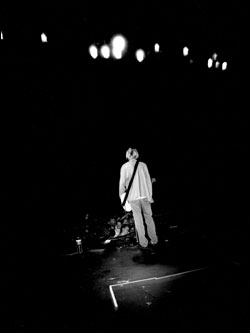Words are overrated, as shown in several notable photo books published this year, all of them excellent gifts for the smarter coffee-table set.
First up: rock stars. The two big Christmas books are cultural antagonists: Charles Peterson’s Touch Me I’m Sick (Powerhouse, $40) is all about the anti-celebrity grunge culture, while Annie Leibovitz’s American Music (Random House, $75) is all about further glamorizing the famous. Peterson captures Kurt Cobain in 1993 with his back to the lens, facing the crowd on a darkened stage. Even if you came across the image outside a book about the grunge era, you’d immediately know him from his slouch, his posture, his isolation on the stage. Peterson’s book is not morbid (indeed, it’s a raucous, youthful celebration), but this photograph is the chronicle of a death foretold. Featured in the ongoing exhibit at EMP, Leibovitz’s collection is far broader, much more magazine-polished, and more superficial, but she’s brilliantly superficial as usual. Iggy Pop baring his abs and leathery flesh in 2000 is just too iconicly posed and composedbut, hey, wouldn’t he be the first to tell you that rock ‘n’ roll is one big pose?
Writers are no more free of vanity (or at least marketing dictates), as reflected in Marion Ettlinger’s Author Photo: 1983-2002 (Simon & Schuster, $35). Here we have Northwest scribes Alexie, Guterson, Raban, Robbins, Doig, and Carver all looking so resolutely serious that you can imagine them bursting into laughter right after the shutter snaps. The large-format, fine-grained approach is meant to commemorate a face we may only see every couple of years (unlike rock stars, actors, and their disposable tabloid brethren), so there’s a whiff of the vaultor at least the darkroomto these mirthless, implacable stares. To know them, it seems, you’d have to buy the book, which is the entire point.
For more serious coffee-table fare, Li Zhensheng’s Red-Color News Soldier (Phaidon, $39.39) is a stunning archive of photos primarily covering the Cultural Revolution of 1966-76. An official state photographer, Li secretly kept this trove under his floorboards, which, if discovered, might’ve resulted in denunciation or death. That very cycle of denunciation and deathor re-education camps, if you’re luckybecomes like a series of Warholian multiples: the same crowds; the same placards around the necks of the disgraced; the same firing squads. Every totalitarian system has its own aesthetic; Li shows us the ritualized, theatrical humiliation of those selected to exorcise the demons of mob rule. In the same vein are the excellent compact photography books Shooting Under Fire (Artisan, $35) and Open Wound: Chechnya 1994 to 2003 (Trolley, $59.95).
Two other new books capture the distinct aesthetics of American subcultures. Brothels of Nevada (University of Nevada, $24.95) isn’t about sex at all, but the gaudy, tacky, chintzed-up, decked-out mobile homes used as whorehouses that can beat the whim of municipal morestrucked to a more hospitable county. Everything in these depopulated frames is ephemeral and cheap, like the transactions conducted within. Black-velvet murals, egg timers, and ATMs dominate the carpeted interiors. Outside, it’s sand and sage and parking lots. In my favorite image, oversized plastic Ionic columns are arrayed outside a prefab cathousejust to lend it a little class, you know? Newly reissued in paper with some color images not previously published, Danny Lyon’s 1968 The Bikeriders (Chronicle, $22.95) is an amazing depiction of Midwestern biker culture located somewhere between The Wild One and Easy Rider. A college boy who rode with the toughs, Lyon is a remarkably sensitive portraitist (and interviewer) of this outsider breed. The tattooed, scarred, grease-stained men may be the coolest, but their oddly tolerant and faithful women come off best.
I love landscape photography, and Art Wolfe’s Edge of the Earth, Corner of the Sky (Wildlands, $75) certainly renders landscape in colors that seem to push beyond a natural palette. It’s broken into zones (arboreal, alpine, polar, etc.), not geographic regionmore like a survey of the planet than a portrait of a place. Still, it’s impossible to look at these photos and not want to book a ticket to Tierra del Fuego immediately. At the other extreme, Edward Burtynsky’s Manufactured Landscapes (Yale, $55) shows the ravages of a natural world under assault by strip mining, railroad grades, and deforestation. It’s less pristine, but feels more true.
Finally, there’s celebrity, in all its familiar yet unfamiliar glory. The marvel to Phil Stern: A Life’s Work (Powerhouse, $75) is how he never treats Marilyn, the Rat Pack, Bogie, Brando, and company to the full Leibovitz-style gloss job. Sure, he shot that kind of stuff for Life and Look, but Stern was a World War II combat photog (covered in one section of the book), and that credibility gave him access to a lot of sets and situations where the stars allowed themselves to be relaxed, ruffled, and uncomposed. He’s an affectionate presence, a peer, not a modern paparazzo, and that affection particularly shows with recording-studio candids of jazz cats like Art Tatum, Lester Young, Billie Holiday, and Ella Fitzgerald with Louis Armstrong. In Hollywood, John Wayne seems unexpectedly tender with his children. Sammy Davis Jr. seems unexpectedly small and fragile. Sinatra seems like somewhat less of an asshole.
My favorite image is of Bogart, sans hairpiece, balanced on a swing set with his young daughter, Leslie, in the mid-’50s. She looks happy. He, like any parent, looks concerned. Married to Lauren Bacall late in life, he’d be dead by 1957, and would never see his two kids from that marriage grow up. He’s seriously, squintingly studying his daughter, as if to fix her image forever on his retinas. It’s like he’s reading a book.








